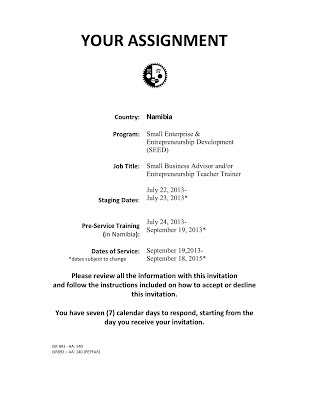People have asked me why I decided to join the Peace Corps, my response… “it chose me”.
I was introduced to the Peace Corps about 7 years ago when I was in highschool. We were talking about international service options in one of my classes and someone brought up the Peace Corps, I was hooked. I knew that once I graduated from college that I was going to join the Peace Corps, move to Africa and work with HIV, mind you, it had been a dream of mine since I was a young child to work with HIV. Once I started college I became very involved in local community service and community development. After 5 years of working on a community level I had been drawn away from the international service idea, and decided to stay and work locally.
Upon graduation in 2011 job prospects were pretty bleak. I worked at a grocery store, then at ITT Technical Institute, which just didn’t work out. I felt trapped. I continued to work on local issues in my spare time, and I even worked on a campaign for my State House Representative, but I still wasn’t happy with the life options that post college existence offered me. I took the first opportunity to leave ITT that I could, I went to work at a law firm for an independent attorney that I knew through the work I had done with the democratic party here in Salt Lake. A short three months later this plan began to fall through.
One day he had asked me to go to lunch with him, he wanted to give me a performance review, he had also asked the other legal assistant to lunch as well. Over lunch after reviewing my performance, he began speaking to me about what I was hoping to do with my life, and how he felt that being a legal assistant wasn’t really my passion…. stating the obvious. But, at this point in time I was just happy to have a job that didn’t make me miserable. I wanted passion and direction back in my life, at this time I thought a career in law was that path.
After lunch I had a feeling that I might be let go… something wasn't settling quite right. When we got back to the office I pulled the other legal assistant to the back room and asked her if she felt the same way, she agreed… one of us wasn’t going to make the cut.
I got home that night, unclear on what my future held. I am the kind of person who always has a plan, and for that plan exists a back up plan, this is the first time in my life that I felt lost, empty if you will. I was flipping through the mail as I spoke with my mother about my day and current frustrations. I saw a postcard from the Peace Corps, inviting my to a get together with returned volunteers who live in my neighborhood. This is the first piece of literature that I received in quite some time; in fact, the notion that I had ever wanted to join had almost slipped my mind.
She told me that I should just apply, after all “what’s the worst that could happen? They say no… then you just figure out another plan”. So that is exactly what I did. That weekend I went to the Peace Corps website, when I logged on I was informed that if I applied then, I could leave Summer 2013.
I applied, interviewed, and on December 20th, I got the call that I had been nominated to work in Community and Economic Development. I filed out some paperwork, and waited. On March 26th I got the email that the 16-year-old girl had been waiting years to get. I was officially invited to work in the Small Enterprise and Entrepreneurship Development (SEED) Program with the Peace Corps in Namibia.
As I said, the Peace Corps chose me; life had a bigger plan for me than Salt Lake City, I just wasn’t ready to see it. It is safe to say that my eyes are wide open to this new chapter in my life. While I know that it will not be an easy adventure, I am confident that it will be worth it, and in 2.5 years when I return home, 16-year-old June will be really proud.



